Taking its cue from Lewis Carroll’s literary classic, In Wonderland: The Surrealist Adventures of Women Artists in Mexico and the United States, at the Los Angeles County Museum of Art (LACMA), was the first Pan-American collaboration of its kind. The exhibition was co-organized by Ilene Susan Fort, a LACMA curator of American art, and Tere Arcq, former chief curator at the Museo de Arte Moderno in Mexico City. In Wonderland sought to “point to a radical rethinking of surrealism as it was outlined in Breton’s manifestos and other writings…and to show new narrative structures that explore the sources of women’s knowledge and power.”1 In other words, it aspired to revive a critical dialogue on Surrealism vis-à-vis today’s global, interdisciplinary lens. Instead of the traditional Parisian epicenter populated by André Breton and his fellow male Surrealists, North American women artists, including European émigrés who practiced in the outskirts of Surrealism, were the focal point.
With over 170 works in a variety of mediums by forty-eight female artists from the 1930s to the 1970s, In Wonderland evoked the heyday of 1930s and 1940s Surrealism. In an homage to Marcel Duchamp’s design for Breton’s First Papers of Surrealism exhibition in 1942, zigzag ropes interlinked the freestanding walls, and large pictorial biographies of the artists were displayed at the exhibit’s end.2 In Wonderland shifted the attention away from the woman as an object of the Surrealist gaze and toward her being the creator of representations as “part of the surrealist movement, expressing a particular vision.”3
Yet this exhibition, while provocative and visually arresting, was also more complicated than it seemed, both in terms of its overall feminist perspective and its “Alice in Wonderland” theme. First, throughout the exhibition these women artists were identified via constant references to their husbands and lovers, privileging the Surrealist men in a show dedicated to women. Second, with an organizational narrative that discarded chronology or individual artist clusters in favor of an arrangement according to the key Surrealist themes, the show itself participated in categories established by the dominant figures in Surrealism, precisely those husbands and lovers whose points of view are all too familiar. Nevertheless, one aspect of this emphasis was to acknowledge the complexity of the challenges facing these women artists, a valid theme for feminist thinking and research. As the spectator went from one Surrealist subcategory to another, In Wonderland underscored the objectification of these women artists as the femme-enfant, embodiment of amour fou, or muse. Like Alice in Carroll’s Alice’s Adventures in Wonderland (1865) and Through the Looking-Glass (1871), the exhibition’s female Surrealists navigated their displacement and creativity in a nonsensical world of mirrors, reflections, and distortions. In my view, In Wonderland fell through the patriarchal rabbit hole of Alice’s Adventures, and got stuck in the glee of amassing such a breathtaking collection. Carroll’s Through the Looking-Glass is more evocative of Surrealist games than Alice’s Adventures is, and Through the Looking-Glass presents a more astute Alice, who undertakes a game of chess against the crafty Red Queen, a very powerful piece.
Alice from Through the Looking-Glass performs in a world of duplicates and binaries, similar to Surrealism’s premise that the conscious and unconscious worlds are a doubling of one another. Alice here is inquisitive and brash; she transforms from pawn into queen. She is not only a femme-enfant within this dreamscape; she is also both the creator and the object of dreams.4 Through the Looking-Glass thus hints at an unforeseen tension not present in Alice’s Adventures, a dynamic of simultaneously possessing subjectivity and being an object for another.5 Alice from Through the Looking-Glass and the chess queen are critically thought-provoking tropes for an exhibition that aimed to “shift the focus from the roles that women artists had played in the creative lives of their male partners to a consideration of the ways that their works engaged with and renegotiated surrealist principles.”6
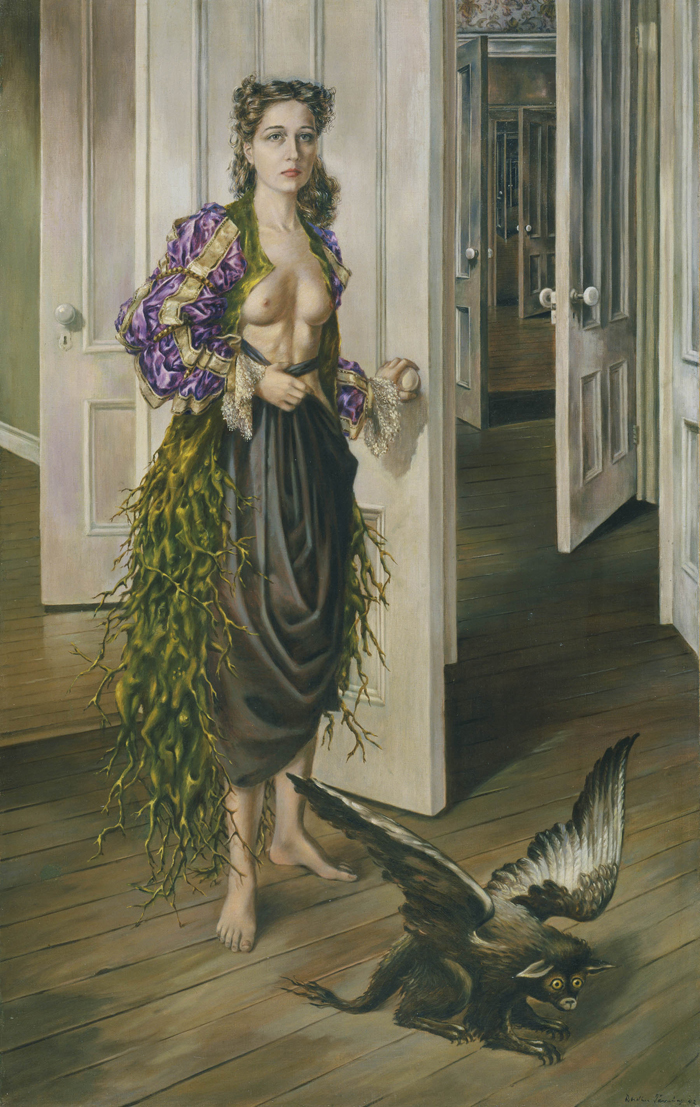
Dorothea Tanning, Birthday, 1942. Oil on canvas, 40½ x 25½ inches. © 2011 Dorothea Tanning Collection and Archive/ Artist’s Rights Society(ARS) New York/ADAGP, Paris. Photo © The Philadelphia Museum of Art / Art Resource, NY.
A2 to A4: Opening Moves
In her groundbreaking book Women Artists and the Surrealist Movement, Whitney Chadwick remarked that between the nineteenth and twentieth centuries, “Surrealism struggled with the inconsistencies of its own polarized visions of woman: one Romantic, the other revolutionary.”7 If Surrealist women were negotiating their identities as artists and women within the terms of this binary, then perhaps In Wonderland could have taken the opportunity to cast an interdisciplinary lens on these “polarized visions” via the chess queen whose task is to protect the king. Moreover, if, as Chadwick writes in the LACMA exhibition catalog, “women artists made surrealism something uniquely their own,”8 then a multidisciplinary scope could perhaps provide the space to articulate women artists’ specific responses to Surrealism’s view of and place for women.
I would propose that the sociopolitical and cultural underpinnings of LACMA’s exhibition may be productively discussed through the perspective of a twofold lens: Through the Looking-Glass’s chess-playing Alice and Julien Levy’s Imagery of Chess exhibition, one of the first on chess and art.9 First, Through the Looking-Glass emphasizes the modern rules of chess where the queen is a crucial piece because of her agility.10 According to Barbara Weissberger, today’s powerful queen piece stems from the Early Modern period, when Spain’s Isabel I was the mastermind behind two key political events: funding Columbus’s first voyage, and successfully completing the reconquest of the Iberian Peninsula from the Muslim kingdoms, i.e. la Reconquista.11 In the fifteenth-century Catalan poem Scachs d’Amor, the chess queen’s newfound power is referred as “worthier and stronger” than the others (“puix que diu que mes val e mes tira”/ Since it is said that she is worthier and stronger).12 Yet much like her Early Modern counterpart, who was used as a political pawn to unify kingdoms by marrying a king, the chess queen’s power is also illusory, because ultimately the game of chess upholds the patriarchal social structure, as Levy’s Imagery of Chess confirms.
In 1932, Levy organized the first Surrealist show in New York, Surrealism: Paintings, Drawings and Photographs, in which Salvador Dalí’s Persistence of Memory made its public début.13 A well-respected art dealer, Levy also hosted the first solo exhibitions of many artists, including Frida Kahlo’s only U.S. exhibition during her lifetime, in 1938. After the Breton-organized exhibition First Papers of Surrealism (1942), Levy launched two critical shows that reflected his visionary insight and curatorial flair, Through the Big End of the Opera Glass (1943), where Carroll’s Alice was the underlying trope, and Imagery of Chess (December 12, 1944 to January 31, 1945) where chess was publicly welcomed as a Surrealist pastime. While Imagery of Chess did include some women artists, the show’s focus was on “the theme of chess, featuring chessboards designed by artists along with related works of art on chess and its metaphors.”14 Additionally, the show included an interactive component, a live blindfold chess event where Marcel Duchamp was the chess master’s interlocutor and where “participants from the show played against reigning blindfold chess master George Koltanowski.”15 While the exhibition was a celebratory tribute to the game of chess, the queen piece appeared only in Dorothea Tanning and Muriel Streeter’s paintings.
The guiding question of In Wonderland was: How did Surrealism challenge women artists to cast new narratives? Like the opening move in a game of chess, where the pawn can move two spaces forward, I would like to recontextualize the artworks and reframe the discussion using the metaphors of chess and Alice from Through the Looking-Glass, specifically in their deployment of the queen piece, to open up a discursive space where the Romantic and revolutionary women of In Wonderland can breathe on their own.
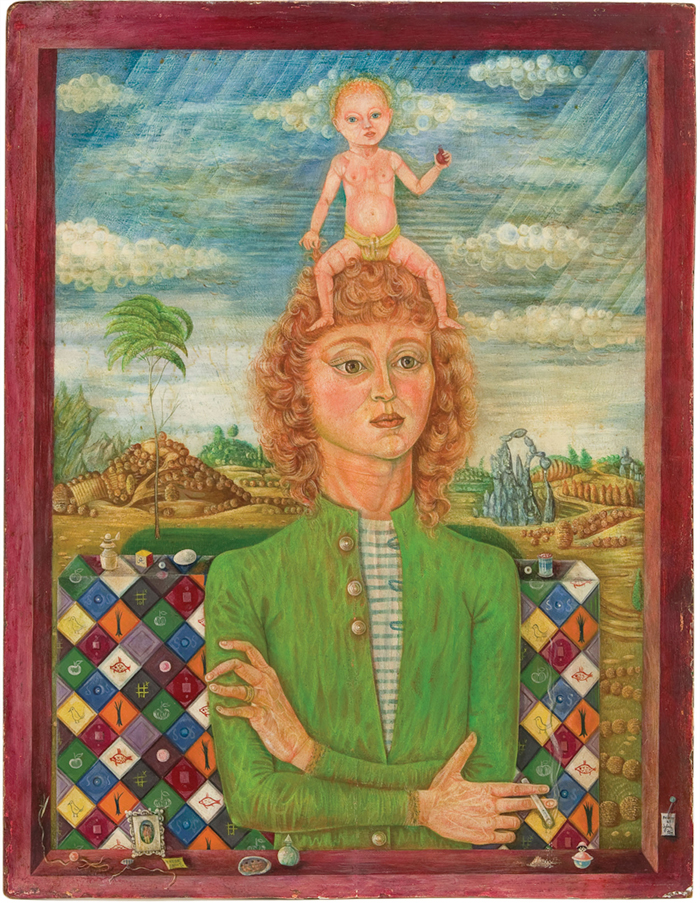
Sylvia Fein, Lady with Her Baby, 1947. Egg tempera on masonite, 18 x 15 inches. © Sylvia Fein. Photo: Eric Tadsen, courtesy of the Chazen Museum of Art.
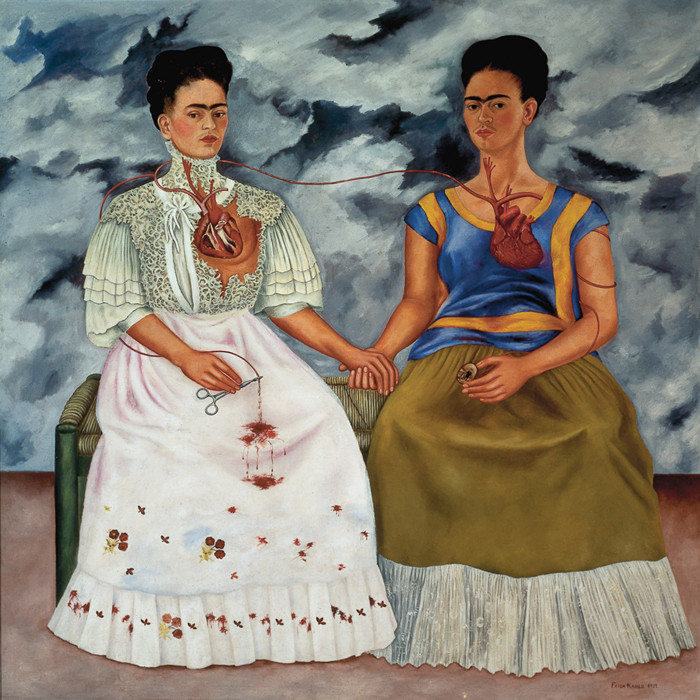
Frida Kahlo, Las dos Fridas (The Two Fridas), 1939. Oil on canvas, 68 5/16 x 68 1/8 inches. © 2011 Banco de México Diego Rivera Frida Kahlo Museums Trust, Mexico, D.F. / Artists Rights Society (ARS), New York. Photo courtesy Museo de Arte Moderno, Mexico City.
Long Live In Wonderland’s Queens!
Entering In Wonderland, clips from Maya Deren and Alexander Hammid’s 16 mm black-and-white film Meshes of the Afternoon (1943) framed the exhibit. The truncated, dreamscape celluloid hung over the threshold and set the tone. Much like Alice’s philosophical quandary of whether she is the dreamer or the dream, Meshes presents a circular narrative. At the beginning a woman (played by Deren) walks back to her home and falls asleep on a chair. While dreaming, she chases a possible Grim Reaper with a mirror for a face with whom she engages in a bizarre, psychological, and murderous adventure wherein the dream itself is questioned. Ironically, since the film was projected so high on the gallery wall, the experience of viewing the film was also impeded. Later in the exhibition, one encountered another of Deren’s films, the unfinished 16 mm black-and-white short Witch’s Cradle (1943). Made in collaboration with Marcel Duchamp, Witch’s Cradle echoes the conscious and unconscious worlds found in Through the Looking-Glass; it shows intermittent scenes of a pulsating heart, a woman wandering through a hallway, a twirling circle with the circuitous inscription “the end is the beginning is the end…,” and Duchamp playing with a piece of string in his hands, which magically travels up his leg and eventually lassoes his neck. Clearly reminiscent of Duchamp’s string installation at the First Papers of Surrealism show (and LACMA’s reiteration of such an environment here), as well as Alice’s philosophical musings after playing the part of a chess queen, Deren’s film invokes the tangle of subjectivity in play.
Dorothea Tanning’s magnificent, hyper-real self-portrait Birthday (1942) opens the show. Prominently displayed as the exhibit’s crown piece, the large painting depicts Tanning shoeless and half-dressed in an outfit made up of Early Modern colors of nobility—an open, flowing purple and gold Renaissance blouse and a green skirt made up of odd-shaped coral or seaweed. She stands before a series of open doorways as a mythical basilisk accompanies her like a loyal pet. The fantastical basilisk is considered the legendary king of serpents, with the power to kill with a glance, but here it is smaller in size than Tanning. As she stands behind it in a protective stance, like a chess queen, her stature does not undermine the basilisk’s power yet emphasizes her own. Motionless and determined before the network of corridors, Tanning’s hand clutches the doorknob authoritatively before she strategically makes her next move.
Nearby, Sylvia Fein’s The Tea Party (1943) is one of the more evocative works to emulate a scene from Alice’s Adventures; it establishes the theme with a petite, smiling Cheshire cat. Fein depicts Carroll’s tea party with a tablecloth, three regal chairs, a bevy of teapots, and an odd assortment of other items. In the background, a Turner-esque sky stands in tension with the foreground’s rather playful landscape. Fein’s Alice is barefoot and holding a teacup as she reclines against an anthropomorphic dirt mound similar to an Italian Mary Magdalene.16 Because of the composition and the use of egg tempera, Fein’s piece is more reminiscent of an Early Modern holy scene; the earth-tone palette recalls medieval gold leaf illuminations, precious pages that emphasize adoration. Fein’s Alice is staged as a significant biblical figure.17 Similarly, in Fein’s Lady with Her Baby (1947), also in the show, a modern woman wearing a green sweater has her arms crossed while a baby rests upon her head like a crown. With a traditional landscape in the background, the painting echoes Byzantine and Early Modern portraits of Madonna and child, where the Virgin Mary was venerated as the Queen of Heaven, and which influenced the physical appearance of the early chess queen piece.18 Lady with Her Baby thus represents a contemporary queen whose imagery is intricately tied with religious dogma and the chess queen. In both of these paintings, the modern clothing accentuates Fein’s aim to refurbish feminine icons and their subjectivity. Hence, Fein’s medium and content are intertwined like two sides of a coin to situate her women in a context of both reverence and modernity.
Given that Frida Kahlo has been extremely popular since her biography by Hayden Herrera was published in 1983, In Wonderland presented a unique opportunity to reexamine some of her works in the context of her female peers.19 The iconic Las dos Fridas (1939) was another key work. Measuring almost six by six feet, the self-portrait depicts Kahlo’s twin European and Tehuana lineages. Both Fridas are seated, holding hands, but dressed in different attire—one in a white lace, floor-length dress stained with dripping blood, and the other in a blue and yellow blouse with green skirt. Linked together by their hearts, one Frida holds her exposed vein with a surgical clamp, while the other clips her vein closed with a small cameo portrait in a compelling stance that is at once vulnerable and imposing. Tere Arcq, co-curator of In Wonderland, has pointed out that this painting represents the duality of women’s identity and sexuality, which underscores the world of mirrors and subjectivity in Through the Looking-Glass.20 Accordingly, like Alice, who is at once a chess pawn and queen, the two Fridas’ juxtaposed cultural costumes portray a very fraught subjectivity in both feminist and postcolonial terms.
Juxtaposed binaries are often seen in the work of Kahlo’s contemporary, Bridget Tichenor. For example, the interlinking contrast of Tichenor’s Líderes (Leaders, 1967) and Encarcelados (The Imprisoned, 1965) warrants further exploration here. In Líderes, Tichenor depicts three figures walking uniformly with canes, one behind the other, underneath an open sky. Each of them wears a bright-colored cloak reminiscent of the Commedia dell’Arte costumes that contrast with their peculiar, serious masks. Their identities are clearly camouflaged and yet their festive procession dominates Tichenor’s composition. By comparison, Tichenor’s Los Encarcelados is a sculpture-object of four stacked wooden cages with bars and painted Masonite heads. Standing just below four feet in height, the eyes of these imprisoned faces are eerily similar to those from the Líderes. In Los Encarcelados, however, they are desolate and restrained. Hence, the whimsy of Líderes is transformed into the immobile, forlorn captives of the Encarcelados. Together these two pieces speak to each other just as Carroll’s two Alice stories do. While Through the Looking-Glass celebrates the fanciful world of its predecessor, Carroll does hold Alice captive in a series of chess masquerades, first pawn and then the illusorily powerful queen; whether the dreamer or the dream itself, Alice is always a pawn in Carroll’s wonderlands. Together, Tichenor’s pieces embrace this contrasting duality of worlds and ambiguity of autonomy.
The sense of confinement is nowhere more evident than in Leonora Carrington’s Green Tea (1942). Foreshadowing her 1975 short story collection, The Oval Lady, Other Stories, Carrington depicts a sole female figure enveloped in a full body black-and-white straitjacket, standing barefoot in a circle on a green lawn.21 In the foreground, two animals, a dog and a horse, are unwillingly leashed to trees. Behind the female figure is an odd-shaped, purple Bosch-like container in which four deer are trapped. In the background, beyond a circular, sculpted hedge, is a landscape garden divided into four parts, with a small fountain. The entrance to this idyllic garden is wide open and not blocked by any gate or object. Within grasp, this possible escape to the Elysian-esque fields is, however, a mirage. Carrington’s female figure is physically restrained, and like Carroll’s Alice, she is not in control of her place within the bucolic setting. Furthermore, this mythological scene of subdued captivity runs parallel to the illusory chess queen’s power, which is always precarious because she can be captured at any time. Carrington thus leaves open the question of whether the real straitjacket is the illusion of autonomy and subjectivity.
Scattered throughout the exhibition are paintings by Carrington’s close friend, Spanish-born Remedios Varo, who lived in exile in Mexico City. Most of Varo’s works convey the idea of fleeing from the confines of a patriarchal world amidst dream-like and fantastical settings. In La huida (1961), Varo re-presents a young weaver who appears in another painting, Bordando el manto terrestre (1961), in which uniformity and not individuality was emphasized. In harmonious, rich oils, La huida’s young weaver flees with a man on an inverted, open umbrella toward a cave in the distance. Varo proffers a very romantic representation of an escape from one enclosed area to another, from Bordando’s communal tower to the lover’s grotto. Varo’s imagination proposes a world where female figures are adventurers, in search of their own autonomy.
Similarly, Lee Miller sought to articulate a woman’s point of view, but through photography. In her black-and-white Untitled (Severed Breast from Radical Mastectomy) (c. 1930), a ghastly, severed breast is depicted on a dinner plate with a place setting. At LACMA, Untitled was displayed where everyone had to pass by; it could not be overlooked. Remembering her nude body as an erotic object in Man Ray’s photos, these unapologetic photos conveyed a brutal re-appropriation of her body and subjectivity.22 Here, Miller simultaneously nullifies one fetishized torso and validates another; she captures the violence of the parting from patriarchal confines. Furthermore, Miller steps through the photographic mirror and dismantles the illusion on her own terms.
Near the end, In Wonderland dedicated one of its thematic spaces to “Games and Technical Innovations.” Within this space, the curators organized a selection of pamphlets, newspaper articles, and artwork from Levy’s Imagery of Chess exhibition. Muriel Streeter’s Neo-Romantic painting The Chess Queens (1944)—a direct response to Max Ernst’s sculpture The King Playing with the Queen (1944)—depicted fashionable black and white chess queens standing on a terrace with no king in sight. Not quite rivals, given their poised and intimate proximity, the queens stand against a landscape scattered with chess figures both living and statuesque. Near them are fallen black and white pawns and a single statuesque bust of a white horse. Behind the black queen, and visually echoing the queens’ friendly stance, are two living horses of each color frolicking. Diagonally opposed are the white and black castles that face each other from opposite shorelines, maintaining the harmonious representation of binaries. If the task of the chess queen is to defend the king at all costs, this painting proposes another narrative, one where Surrealist women artists sustained friendships, both to protect themselves and to propose an imaginary space of feminine fantasy and power. In my view, The Chess Queens thus opens up the exhibit’s complex discursive space because it offers one of Surrealism’s “polarized visions” of women, the Romantic one.23
If Streeter’s The Chess Queens is the subtle response to Surrealism’s romantic vision of women, then Dorothea Tanning’s dramatic The Game of Chess (1944) is the gruff retort to its revolutionary one.24 Exhibited also in Levy’s Imagery of Chess, The Game of Chess portrays a warped chessboard divided diagonally into two sections by different colors, emphasizing that chess is a game of wits and dominance. In the upper right-hand corner is a closed-in area that depicts a two-dimensional representation of the game’s four rooks, two pale in color and the others darker in hue; they are boxed in, captured and out of play. In the lower left-hand corner, the terrain of warfare and peacetime is unequal because of an amorphous outline of a gaping hole in which a sweeping countryside is portrayed. In the center are two symbolic objects: a bishop’s miter, representing the church and patriarchy, and a white satin high-heeled shoe representing the queen. The shoe stomps on the miter, and bubbles escape from this violent encounter. The queen has aggressively captured the bishop (life gurgles out of his chapeau) and vividly won this turn. As a final visual punctuation of the queen’s agility, a geometrically interweaving dashed line connects the shoe to the captured rooks above. Like the world of Through the Looking Glass, the chessboard’s duality asserts that power is comprised of battles and ceasefires, conflict and resolution, and men and women. Furthermore, unlike Streeter, who encapsulated female community as an idyllic, romantic escape, Tanning’s painting is a revolutionary assault where the chess queen confronts patriarchy and leaves it crushed under her high heel. Hence, The Game of Chess and The Chess Queens offered the exhibition’s two finest examples of Surrealism’s “polarized visions” of women. They not only linked all of the forty-eight female artists together through the trope of Carroll’s chess queen, but also were the cornerstones to In Wonderland’s complex and understated narrative.
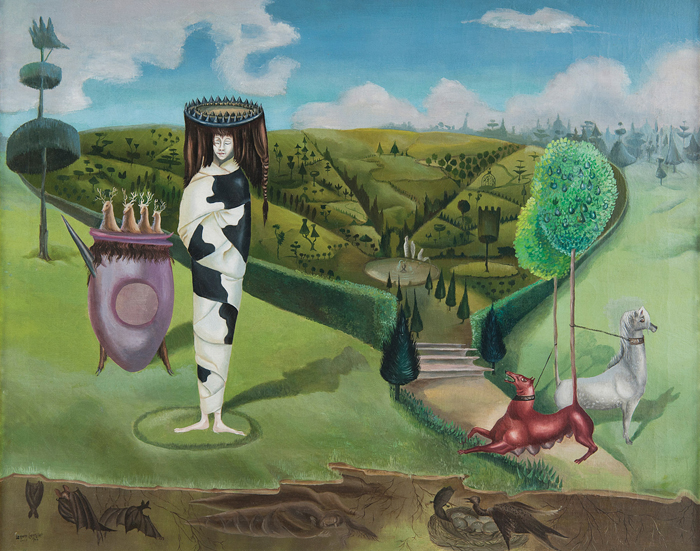
Leonora Carrington, Green Tea (La dam ovale), 1942. Oil on canvas, 24 x 29 15⁄16 inches. © 2011 Estate of Leonora Carrington/ Artists Rights Society (ARS), New York. Photo © 2012 Museum Associates/LACMA, by Jorge Perez de Lara.
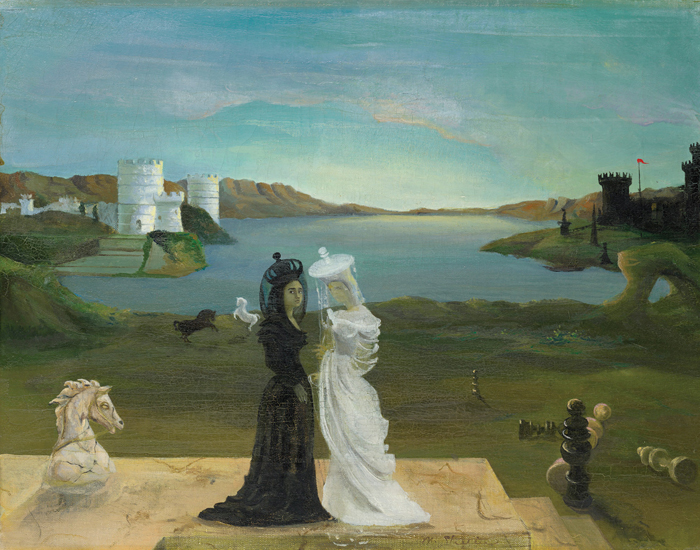
Muriel Streeter, The Chess Queens, 1944. Oil on canvas, 13½ x 17¾ inches. Photo © Wadsworth Atheneum Museum of Art / Art Resource, NY.
Checkmate
In Wonderland was an extraordinary exhibition that could have pushed its critical interdisciplinary approach further. Up against the complex realities of history, In Wonderland could not cast a completely new narrative to rethink the art practice of Surrealist women artists. Nevertheless, considering the show against a background of the women artists’ deployment of the figure of the chess queen, it’s possible to acknowledge the complexity of a world in which the woman artist may be a protagonist, articulating her own subjectivity, yet is at the mercy of a structure where the position of the king is decisive. Like Alice, these women artists were both the creators and objects of dreams. Challenged by Surrealist principles, they negotiated them in a variety of ways, by stepping behind and sometimes through the mirror to show us their visions of creativity, displacement, and autonomy.
Nhora Lucía Serrano is Assistant Professor of Comparative Literature at California State University, Long Beach. She is currently working on her book Resisting Images: Dali and the Art of Illustration.
